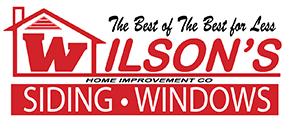When considering an exterior update to your home, it is important to weigh all your options. Below, we compare 3 popular types of exterior cladding.
Vinyl siding, composed of Polyvinyl Chloride (PVC), is an affordable, long-lasting and virtually maintenance-free cladding choice for any home’s exterior. Vinyl siding is offered in many styles, textures and colors, including many with the look and feel of real wood. Vinyl siding yields an exceptionally high rate of return on your investment. Add matching soffit installation or vinyl siding trim packages for a truly cohesive exterior.
Strengths |
Weaknesses |
|
Durable construction and long lasting finish |
|
|
Features one of the lowest installed costs, with a very large payback on investment |
|
|
Vinyl siding is virtually maintenance free, no painting, sealing or caulking required |
|
|
Available in a wide array of colors with fade-resistant finishes |
|
|
Profiles mimic the natural look of wood siding available |
|
|
Rot and insect damage resistant |
|
|
Available vinyl soffit and architectural trim elements create a designer look |
|
|
Ideal with a variety of architectural styles |
|
|
A lifetime warranty usually offered |
|
|
Outperforms most other exterior cladding choices, including brick, in many environments. |
Fiber cement siding is made from a mix of wood pulp, sand, cement and bonding additives. It is formed into long boards or shingles and is attached to your home directly with nails. Available pre-primed and painted.
Strengths |
Weaknesses |
|
Does not rot; resists moisture, insects and pests |
Costs more than vinyl products |
|
Looks similar to real wood. Offered in a range of styles like shakes and lap siding |
Pre-painted more expensive than primed unpainted |
|
Does not expand/contract as much as real wood |
A heavy product; can add thousands of pounds to a typical house |
|
Paint friendly – if you like to paint |
Product warranties may be limited and are often pro-rated. Removal of existing siding may be required |
|
Fire Resistant |
Caulking and periodic re-caulking of seams required to prevent water damage |
|
Pre-primed and painted finishes are available |
Absorb moisture, crumble and delaminate if not maintained. |
|
Nails can loosen and panels may lift away over time |
|
|
Special cutting tools and respirators to prevent inhaling toxic silica dust may be required. |
|
|
Limited insulation properties or R-Value |
Insulated siding is vinyl siding with rigid foam plastic insulation that may be laminated, or otherwise permanently attached by the manufacturer. Insulated siding provides the style, and durability of regular vinyl siding, but the energy efficiency is questioned. It isn’t a bad panel if your home is adequately insulated already.
Strengths |
Weaknesses |
|
Rot and insect damage resistant |
Darker colors in wider profiles may not be available at this time |
|
Durable |
The rigid backing curtails air movement and fills the wall system’s drainage plane. Filling the gap between the vinyl siding and the wall system takes away the major performance benefits of vinyl as an exterior cladding. There’s no drainage plane to manage condensation and long-term vapor accumulations and eventually, rot. |
|
Vinyl siding is virtually maintenance free, no painting, sealing or caulking required |
Foam insulated back makes it impossible to continue the insulation at the seams between the pieces of siding. This can leave 1-3 inches of space at every seam, around your home with NO insulation, thus, limiting the true energy efficiency of insulated vinyl siding |
|
A lifetime warranty usually offered |
However, if a vapor barrier is NOT installed with your insulated panel, it will void the manufacturer’s warranty. Some companies do not add that barrier. |
Once you have done your research and decide you want vinyl siding as the exterior upgrade for your home, give us a call. We would love to opportunity to earn your business!
Categories:Arkansas, Vinyl Siding, Siding, Energy Savings, Estimates
Comments: No comments yet


Post a comment